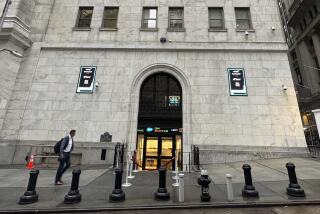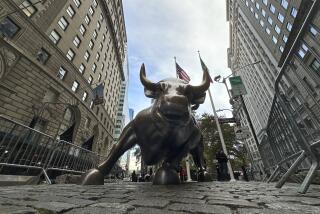Dow Hits 8,000, Another Bull Market Milestone
The roaring U.S. bull market in stocks passed another milestone on Wednesday, as falling interest rates and surging corporate earnings helped send the Dow Jones industrial average to its first close above the 8,000 level.
Amid extraordinarily heavy buying of major technology stocks, the Dow index rose 63.17 points to a record 8,038.88--the sixth âmillenniumâ mark the blue-chip index has passed since the current bull market began in October 1990.
In a decade in which nearly every superlative that could describe the marketâs performance has already been used many times over, Wall Street analysts conceded they had little new to add.
âWeâre going to look back on this period someday and say, âWe really had it great,â â said Dennis Jarrett, head of Jarrett Investment Research in Westport, Conn.
Indeed, the trigger for Wednesdayâs gain was another batch of government data showing that the U.S. economy--which itself has been labeled with countless superlatives in recent years--is growing at a moderate pace, with almost no inflationary pressures evident.
âPeople are willing to pay even more for [stocks in] an ideal background of low inflation, moderate interest rates and strong earnings momentum,â said Michael Metz, a longtime market skeptic and investment strategist at New York brokerage Oppenheimer & Co.
That portrait of continuing economic nirvana gained more credibility Wednesday with the governmentâs report that the consumer price index, the standard measurement of inflation at the consumer level, rose just 0.1% in June, the same minuscule rise as in four of the previous five months.
In the first half of 1997 the annualized inflation rate was a mere 1.4%--the lowest pace for the first half of any year since 1986, when energy prices were plummeting.
Long-term bond yields tumbled on the inflation news, sending the yield on the bellwether 30-year U.S. Treasury bond to 6.48%, down from 6.54% on Tuesday and the lowest since last Dec. 9.
The slide in bond yields in recent weeks could set the stage for lower mortgage rates ahead, potentially giving another boost to the California housing market, where sales have been robust lately.
More important from Wall Streetâs view, falling interest rates and low inflation are almost always positive for stock prices, in large part because they make interest-paying competitive investments, such as bonds and money-market securities, as well as hard assets such as gold, seem far less attractive compared with stocks.
âThe question [for many investors] continues to be, âWhat else are you going to do with your money?â â if not buy stocks, Jarrett said.
That mentality helped drive the Dow up 33.5% in 1995, 26% in 1996 and 25% already this year, in the process luring more Americans to the market. By one measure households are now estimated to own 55% of U.S. shares, including their stakes in mutual funds, which have ballooned with the inflow of cash coming from burgeoning 401(k) retirement plans.
Yet as U.S. share prices continue to climb--reaching record levels not only in absolute terms, but also relative to corporate earnings, dividends and other key measures--some analysts warn that the market is increasingly vulnerable to any sliver of bad news.
âStocks are in a classic late-cycle blowoff analogous to 1929 and 1987,â argues David Shulman, investment strategist at brokerage Salomon Bros. in New York. âWhile we do not envisage a 1929- or 1987-style collapse, a 20% decline would not be out of the question.â
In fact, the market has had two major pullbacks in the last 12 months, in March and April of this year, and in June and July of 1996. In both cases the Dow index sank almost 10%--only to quickly rebound.
On Wednesday, however, worries about the marketâs heights took a back seat to the desire of more investors to get in, and quickly.
Besides the Dow, all other major market indexes set records, with the Nasdaq composite stock index, laden with technology stocks, soaring 2.5% to its 10th consecutive record.
Fueling the tech sectorâs gains was a characteristically upbeat earnings report from Intel Corp., the dominant computer chip maker whose fortunes are thought to closely reflect those of a wide range of technology companies.
Intelâs second-quarter earnings, which rose 59% and slightly exceeded analystsâ projections, were reported after Tuesdayâs market close. On Wednesday, Intel shares zoomed $7.46 to a record $88.38, adjusted for a 2 for 1 stock split this week.
Other strong earnings reports lifted stocks of such firms as BankAmerica Corp., airline giant AMR Corp. (parent of American Airlines) and telecommunications equipment firm Lucent Technologies, and demonstrated that despite the economyâs slower pace in recent months, companies continue to wring out healthy profits.
Another technology bellwether, Microsoft Corp., soared $9.97 to a record $148.44, making it the nationâs second-largest company in market capitalization--that is, the total market value of all its outstanding shares--ahead of Coca-Cola and behind General Electric.
Microsoft, the world leader in personal computer software, now is valued by investors at a stunning $178 billion. Its market value has more than doubled over the past year alone, as investors have particularly chased after stocks of multinational U.S. companies whose global growth prospects are considered extremely positive.
The 30-stock Dow index, the best-known gauge of U.S. multinational shares, has risen 50% from its lows last summer.
For all that, the Dowâs close at 8,038.88 represented more of a psychological and popular milestone than a meaningful financial one.
âThe surge today is really less than 1%,â noted Michael Lipper, head of mutual fund-tracker Lipper Analytical Services in New York. âItâs been climbing up and flirting with this [the 8,000 mark] for a week or more.â
Moreover, while the Dowâs latest rise appears to be exponential when viewed on a typical price chart--where the fever line may be headed straight up--that is misleading. As the index goes higher, the gain between milestones shrinks in percentage terms.
The Dowâs move from 1,000 to 2,000--a gain of 100%--took more than 14 years, from November 1972 to January 1987. But the index traversed the distance from 6,000 to 7,000--a gain of 16.7%--in 11 months, and it broke 8,000, which represented a further gain of 14.3%, just over five months later.
Still, demand for stocks is unquestionably strong, as investors in the United States and in most of the world respond to remarkably benign fiscal and economic environments and to indications that global prosperity can be sustained.
The German stock market, for example, is up 45% this year. The Mexican market is up 42%. Only in Southeast Asia, where countries have recently suffered currency devaluation amid a rise in bank loan troubles and higher trade deficits, have stocks been depressed.
The surge in most world stock and bond markets has enriched individual U.S. investors who own securities through mutual funds. Assets for all mutual funds, including stock, bond and money market funds, now total a record $3.9 trillion, according to the Investment Company Institute, a mutual fund trade group.
Between 35% and 50% of those fund assets are in retirement accounts, which tend to remain in place for long terms--and thus may be less subject to impulse selling in the event of a market downturn.
On the other hand, the stellar growth of fund assets may mean that many Americans are beginning to assume that the historically unusual investment returns turned in by the stock market in recent years can continue indefinitely.
âItâs a matter of some concern that the rates of return being earned by equity funds are substantially higher than what is being earned by the corporations in the portfolios,â Lipper observed. âAt some point, that canât go on.â
In fact, economists and market analysts continue to debate how high is too high.
Some argue that once-in-a-lifetime improvements in productivity, subdued inflation, the post-Cold War atmosphere of international economic cooperation, and more efficient government management of monetary policy justify sharply higher prices for stocks and lower interest rates worldwide.
âThe ânew eraâ model is becoming very fashionable,â said Edward Yardeni, chief economist at Deutsche Morgan Grenfell, who forecast in 1995 that the Dow would hit 10,000 by the end of 1999.
At 6,000 and 7,000, âthere was more nervousness about the market,â said Yardeni. âNow that everybody recognizes the bullish fundamentals, Iâm looking for what can go wrongâ on the way to 10,000. âThe major risk for stocks is that we move too high too fast.â
âThereâs some evidence out there that the argument that âthis time itâs differentâ is sustainable,â John C. Bogle, chairman of the Vanguard Group of mutual funds, said earlier this year in a meeting with Times editors and reporters. âI think itâs wrong, but it can be rationally sustained.â
Times wire services contributed to this story.
* BULL MARKET: Whatâs behind surge. D1, D6
(BEGIN TEXT OF INFOBOX / INFOGRAPHIC)
Market Mania
Investing is no longer the exclusive province of affluent older Americans. A look at stock ownership as the market surges over 8,000.
WHO OWNS STOCKS
43% of Americans own stocks (doubled in seven years).
10% of those have started in the past 10 years.
47% of investors are women.
55% of investors are under age 50.
****
Households (includes mutual funds): 55%
Pensions: 25%
Foreigners: 7%
Life insurance: 5%
Others: 8%
****
â91
3,000.00
â94
4,000.00
â95
5,000.00
â96
6,000.00
7,000.00
â97
8,000.00
More to Read
Inside the business of entertainment
The Wide Shot brings you news, analysis and insights on everything from streaming wars to production â and what it all means for the future.
You may occasionally receive promotional content from the Los Angeles Times.










